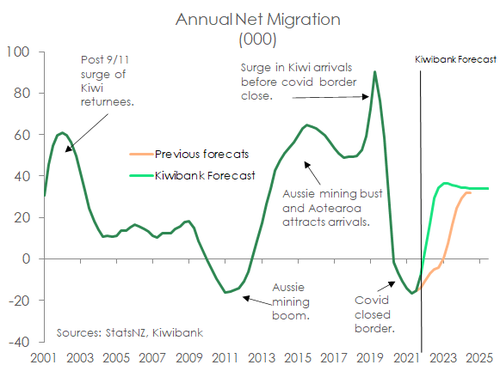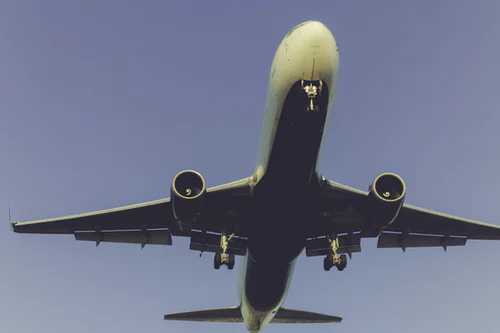
- Net migration looks to have turned. From a 17,000 annual outflow at the start of 2022, to just over 8,000 in September. And we’re forecasting significant net migration inflows of over 30,000 people next year.
- After jumping out of the gates earlier in the year, long-term departures may have steadied. Meanwhile, long-term arrivals, mainly from non-NZ citizens, are rapidly recovering.
- If correct, our migration projections will be a mixed blessing for the RBNZ. While rising net migration will provide some relief to firms crying out for workers, it will also add to the demand for everything.
Since our last examination of migration flows, we have been surprised at how quickly the numbers have turned. The speed of the migration recovery came despite visa application delays and the delay in opening our borders to non-visa waiver countries. Aotearoa is now starting to see migrant arrivals outstrip departures – a net migration inflow. There was a circa 2,000 net migration inflow in the month of September, the highest gain since pre-covid. Although September’s number was still only a third of the monthly average recorded over 2019. It appears that after jumping out of the gates earlier in the year, long-term departures may have steadied. Meanwhile, long-term arrivals, mainly from non-NZ citizens, continue to steadily recover.
On an annual basis there was still a net outflow of 8,400 in September. But that was down from around 17,000 at the start of winter. A meaningful trend is developing. We have upgraded our net migration forecasts and now expect an annual peak of around +36,000 in a year’s time. That would still be well below the average of the five years preceding covid of close to a 60,000 net inflow. It is difficult to compare to the pre-Covid period, as the 2014-2019 period was the largest migration boom in recent history. Nevertheless, the lower peak of around +36,000 reflects tighter immigration settings and strong competition from other developed countries for skilled migrants.
As economists we are mainly concerned with the net flow of people. That is, long-term arrivals less long-term departures across the border. Net migration is a key swing factor in NZ’s population growth. And over the long-term, Aotearoa needs to maintain positive net migration. Like most developed economies, we have an aging population, and the fiscal bills associated with aging are taking up a greater share of the public purse. NZ’s retired population will be reliant on a smaller pool of younger Kiwi. A quick look at NZ’s dependency ratio (the number aged 65+ per 100 people of working age 20-64) has grown from around 15 in 1960 to 26 in 2021. And while NZ is ranked around the middle of OECD countries (a group of mainly developed economies) our dependency ratio will trend higher over the coming years. 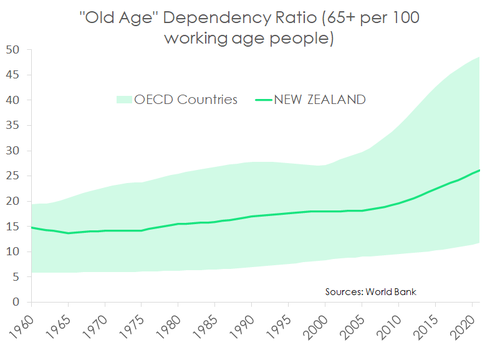
But here and now, a faster rise in net migration has two main impacts on the economy. Unfortunately, for the RBNZ, these impacts work against each other as it rebalances aggregate supply and demand. First, a faster turnaround in net migration will be welcome by firms struggling to fill vacant positions. Migrants may take the edge off the peak in wage growth. However, rising population growth will also add to aggregate demand. More people mean more of everything, including the need for more houses. And the shift (higher) in demand comes when the RBNZ is trying to cool everything down. The Kiwi economy’s supply capacity is still playing catch-up. For instance, Aotearoa is still addressing the infrastructure deficit, brought about in part by the migration boom seen between 2014 and 2019.
Breaking migration down.
Let’s start with the long-term flow of Kiwi across the border. A key influence is the relative strength of NZ’s labour market compared to major emigration destinations – like Australia. For instance, the Aussie mining boom of the early 2010s attracted many Kiwi across the Tasman. And at that time, the Kiwi economy was still hurting from the fallout of the 2008 financial crisis.
The pull of work is a powerful one when it comes to migration flows. Since covid-related border restrictions were relaxed at the start of the year, we have seen an exodus of Kiwi heading offshore. The exodus was in part due to the pent-up desire of many young Kiwi to see the world. And the world has been crying out for Kiwi workers.
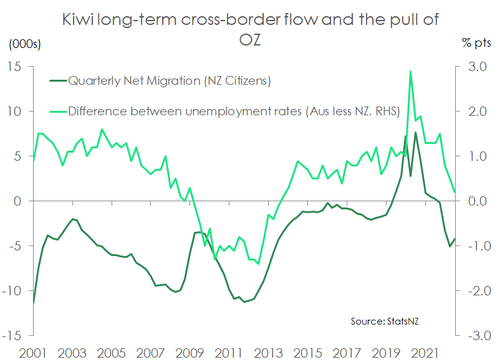 As the chart above shows, the Australian labour market has tightened faster than NZ’s this year. At the same time, we have witnessed a return to net outflows of Kiwi offshore. We expect the Aussie labour market to retain its relative strength over the next year. The relative story is also a monetary policy one. Faced with a much faster jump in inflation the RBNZ has been far more aggressive than the RBA in pouring cold water on the economy. Our unemployment rate may rise faster than Australia’s as a result. A measurable outflow of Kiwi is likely to occur for the foreseeable future.
As the chart above shows, the Australian labour market has tightened faster than NZ’s this year. At the same time, we have witnessed a return to net outflows of Kiwi offshore. We expect the Aussie labour market to retain its relative strength over the next year. The relative story is also a monetary policy one. Faced with a much faster jump in inflation the RBNZ has been far more aggressive than the RBA in pouring cold water on the economy. Our unemployment rate may rise faster than Australia’s as a result. A measurable outflow of Kiwi is likely to occur for the foreseeable future.
More than offsetting the net outflow of Kiwi is a sharp rise in non-NZ net migration. There is a solid desire to come to Aotearoa at present and this is reflected in a sharp rise in migrant arrivals. In the space of just three quarters, we have seen a sizable 5k a quarter outflow turning into an almost 10k inflow. Worldwide searches on Google for “NZ visa” related terms have skyrocketed since our border reopened (see chart below). We recognise that an online search is a long way from actually moving to NZ. Some of these search terms simply reflect the desire to travel, not the willingness to live in NZ. And for some countries, such as China, they are underrepresented in the data. In China, homegrown search engines are more widely used than google. 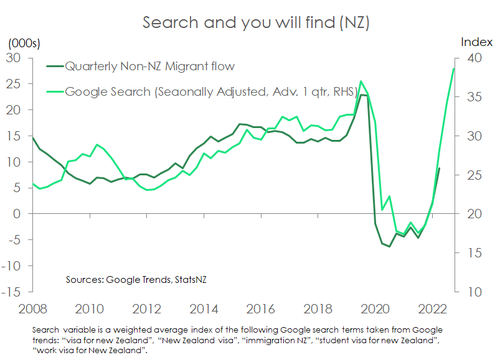
Nevertheless, the data signals a sizable desire to move to our corner of the world. The Aotearoa ‘brand’ has performed remarkably well throughout the pandemic, and we should never underestimate our international pulling power. We are likely to see a continued increase in non-NZ migrant inflows ahead. We are picking quarterly inflows will top 15k early in 2023, before easing. Immigration settings are more restrictive than what was in place over much of the 2010s. Also, NZ is competing with other developed countries for skilled migrants. The net result of these forces means we are expecting a surge in annual net migration numbers to around 36,000 by the end of 2023 before settling to an average of between 30,000-35,000.
